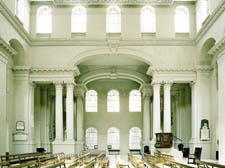|
|
 |
| |
 Renovated church interior Renovated church interior |
Inside the church rebuilt by a galloping Anglophile
Bloomsbury’s famous Hawksmoor church has just had a £9.5 million makeover.
THERE can be few churches anywhere in the country that could have endured the drastic interior changes that have taken place at St George’s, Bloomsbury, over the last five years.
And finally the results of the £9.5 million restoration, which came about after a unique agreement between the late American philanthropist Paul Mellon, the World Monument Fund and English Heritage, are to be officially unveiled to the public.
Since the work began in 2001, the famous lions and unicorns on the church spire have been lovingly renovated, stucco work delicately attended to and new painting done throughout.
But the most astonishing aspect of the scheme is that the entire axis of the church has been altered.
Whereas once visitors would ascend the grand Bloomsbury Way portico to see the wooden reredos and altar in the north end of the church, it has been returned to the eastern end of the perfectly square church, where it originally stood when Nicholas Hawksmoor – the celebrated pupil of Sir Christopher Wren – envisaged it in the early 18th century.
The church is hosting a series of events to mark its reopening, with the rededicaction of the church by Richard Chartres, the Bishop of London, in the presence of the American Ambassador Philip Lader and Prince Michael of Kent, and a public service at 6.30pm today (Thursday), the launch of a classical music series and a special gala event next Saturday.
But Perry Butler, who has been Rector of the church since November 1995, is fully aware that the job is a long way from completion. In the north side of the church, where once stood the altar, an entire gallery needs to be erected and the undercroft is in the process of being converted into museum.
He said: “Inevitably, in a project such as this things are more complicated than is originally envisaged. Things take longer than you want and there are details that need to be attended too.”
The long process began soon after Revd Butler took charge. He arrived at the church in November 1995 when its fortunes were low. The building was in a state of disrepair and the local community and church was struggling to cope with an horrendous drug and homeless problem. The theft of its donation box was a regular occurrence.
After he had been at the church a couple of years, building up the congregation, it was decided that the building could wait no longer and an application for £250,000 was submitted to English Heritage to pay for the waterproofing of the building and renovation to the exterior.
The application was refused, but crucially the church was included in the World Monuments Fund Buildings at Risk Register, bringing it to the attention of the wider community.
But it was the donation of £5.4 million by the estate of the late American philanthropist Paul Mellon, supplemented by a grant of £2.8 million by the Heritage Lottery Fund, which led to the massive project being undertaken.
Revd Butler said: “We were visited by the executor of Paul Mellon’s estate Ted Terry and he thought by restoring St George’s, it could be a tangible sign of the regeneration of the area. Our architect Colin Kerr, who devised the whole plan, said it was a once-in-a-lifetime opportunity.”
As the project developed so did the requirements and it became clear that the whole structure of the church needed to be looked at afresh.
Revd Butler said: “We couldn’t go straight back to the 1730s but we had to imagine what Hawksmoor would have come up with for a working church in the 21st century.
“We looked at his original brief and in many respects tried to follow that.”
The congregation, which Revd Butler concedes suffered while the work was carried out, were forced to worship at a succession of out buildings at the end of November 2003 and it wasn’t until the end of 2005 that services resumed inside the church.
One of the most controversial aspects has been the replacement of the Victorian pews. There are few things which trigger the emotions of a congregation more than pews and these new ones are strikingly elegant and carved in oak.
More importantly they are easy to move around for services, concerts or any other event inside the church.
Much of the attention recently has gone on the considerable architectural achievements that have been completed over the last five years but Revd Butler is particularly keen to stress that the church is fully working and active in the community.
He said: “It does frustrate me that some people wander in and say that they had passed the church when it was closed and wondered what it was like. We never closed.” Revd Butler is keen for people to know that a music programme has been launched, as well as an exhibition about Hawksmoor and that the church museum will be opening by the end of the year in the undercroft.
Various projects with schools have also been launched.
Revd Butler is very proud of a plaque which is dedicated to Paul Mellon, whose money made the whole restoration happen, which will be unveiled at a private ceremony on Thursday morning.
The plaque is one of the few totally new features of the renovation.
It it says: “The restoration of this church was made possible by the generosity of Paul Mellon, American philanthropist and galloping Anglophile.”
“It’s what he liked to be called,” laughs Revd Butler. |
| |
|
 |
|